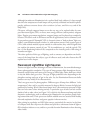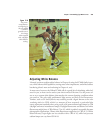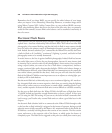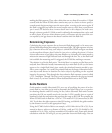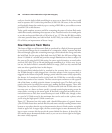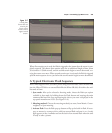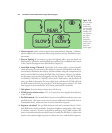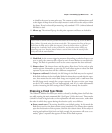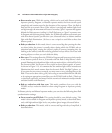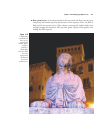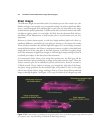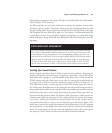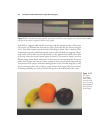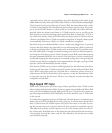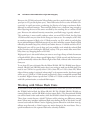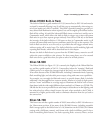■ Rear-curtain sync. With this setting, which can be used with Shutter-priority,
Aperture-priority, Program, or Manual exposure modes, the front curtain opens
completely and remains open for the duration of the exposure. Then, the flash is
fired and the rear curtain closes. If the subject is moving and ambient light levels
are high enough, the movement will cause a secondary “ghost” exposure that appears
behind the flash exposure (trailing it). You’ll find more on “ghost” exposures next.
In Program and Aperture-priority modes, the D7000 will combine rear-curtain sync
with slow shutter speeds (just like slow sync, discussed below) to balance ambient
light with flash illumination. (It’s best to use a tripod to avoid blur at these slow
shutter speeds.)
■ Red-eye reduction. In this mode, there is a one-second lag after pressing the shut-
ter release before the picture is actually taken, during which the D7000’s red-eye
reduction lamp lights, causing the subject’s pupils to contract (assuming they are
looking at the camera), and thus reducing potential red-eye effects. Don’t use with
moving subjects or when you can’t abide the delay.
■ Slow sync. This setting allows the D7000 in Program and Aperture-priority modes
to use shutter speeds as slow as 30 seconds with the flash to help balance a back-
ground illuminated with ambient light with your main subject, which will be lit by
the electronic flash. You’ll want to use a tripod at slower shutter speeds, of course.
As shown in Figure 12.9, it’s common that the ambient light will be incandescent
illumination that’s much warmer than the electronic flash’s “daylight” balance, so,
if you want the two sources to match, you may want to use a warming filter on the
flash. That can be done with a gel if you’re using an external flash like the SB-900,
or by taping an appropriate warm filter over the D7000’s built-in flash. (That’s not
a convenient approach, and many find the warm/cool mismatch unobjectionable
and don’t bother with filtration.)
■ Red-eye reduction with slow sync. This mode combines slow sync with the
D7000’s red-eye reduction behavior when using Program or Aperture-priority
modes.
In Shutter-priority and Manual exposure modes, you can select the following three flash
synchronization settings:
■ Front-curtain sync/fill flash. This setting should be your default setting. This
mode is also available in Program and Aperture-priority mode, as described above,
and, with high ambient light levels, can produce ghost images, discussed below.
■ Red-eye reduction. This mode, with its one-second lag and red-eye lamp flash, is
described above.
David Busch’s Nikon D7000 Guide to Digital SLR Photography412



